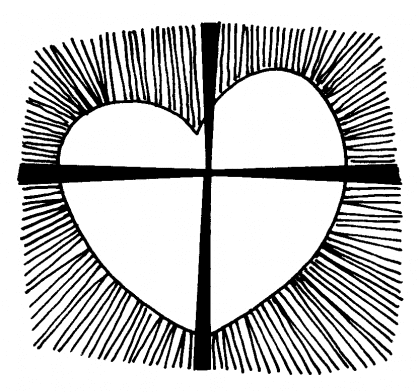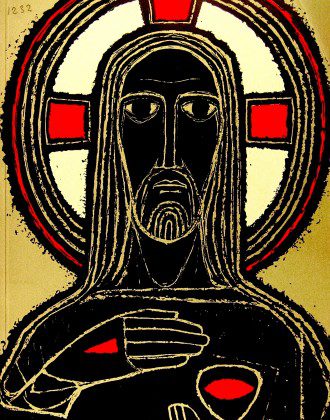“…take my soul into your most sacred wound, so that in this school of love, I may learn to make a return of love to God, who has given me such wondrous proofs of his love.”
Line 1
Each week David Schimmel, our province director of Dehonian Associates, posts reflections and prayers on the “Dehonian Spirituality” page of the website. See previous weeks’ reflections under the various headings on the left side of the Dehonian Spirituality page or use the drop-down menu at the top of this page under “Dehonian Spirituality.”
POSTED: April 25, 2014
Anniversary of the establishment of the United States Province of the Priests of the Sacred Heart
 The first Priest of the Sacred Heart who came to the United States was, in all probability, Fr. Leo John Dehon. Participation in the Eucharistic Congress, held in Montreal, occasioned the trip that took him around the world. This journey, from August 8, 1910, until March 2, 1911, was not an excessive indulgence of his passion for travel, but rather a decisive step in the internationalization of the Congregation.
The first Priest of the Sacred Heart who came to the United States was, in all probability, Fr. Leo John Dehon. Participation in the Eucharistic Congress, held in Montreal, occasioned the trip that took him around the world. This journey, from August 8, 1910, until March 2, 1911, was not an excessive indulgence of his passion for travel, but rather a decisive step in the internationalization of the Congregation.
A month before he began his journey he wrote to a friend saying, “I have to go on a long voyage to Canada and America. You know that we are going to begin some new works over there. The German Province is negotiating to establish a ministry in Dubuque in the United States. The French Province will start in Canada.”
Fr. Dehon spent about six weeks in the United States, visiting most of the major cities. On September 1, he records in his diary, “An excursion to Dubuque, Iowa, the Hawkeye State. This name probably is taken from an old Indian tribe. Dubuque is a minor city of 40,000. What drew me here was the prospect of starting a mission. Fr. Herr, the pastor of St. Mary’s, made the proposal that we set up a children’s home, what they call over here a training school. The bishop would donate a nice piece of land with a farm on a picturesque setting outside of town. I went to meet the good pastor of St. Mary’s. He is German and so is half the town. They are religious and industrious people. I also saw Bishop Kean. He is in poor health and too old to deal with such an important matter. We’ll see about this later on.” Despite the initial conversations, this ministry never materialized.
Only after the devastation of World War I did Fr. Mathias Fohrman, SCJ, arrive in New Jersey on December 31, 1919. His immediate purpose in coming to the United States was to collect funds for the financially strapped German Province. However, he was also to look for the opportunity to establish the Congregation on American soil. After three lonely years as the only SCJ in America, while engaging in the difficult and distasteful task of begging for money, his Superiors informed him that the Bishop of Lead, South Dakota, would welcome him to minister on the Indian reservations of his diocese.
On Palm Sunday, 1923, Fr. Fohrman took possession of the mission church in Lower Brule, South Dakota. This mission became the springboard to launch the Congregation’s efforts to establish an American identity and eventually an American Province. Only three years later, Sacred Heart Mission House and Minor Seminary in Ste. Marie, Illinois, welcomed its first three candidates. St. Joseph Indian School in Chamberlain, South Dakota, began to receive children in the fall of 1927, and by mid-1929, there was a Novitiate at Sacred Heart Monastery, Hales Corners, Wisconsin.
Surprisingly, in the spring of 1934, the fledging community received a document from Rome announcing the establishment of the American Province. According to Father Kiefer, an early SCJ pioneer in America, the community had not requested it. He later found out that when the Superior General had gone to the Vatican to present his Five-Year Report, the pope advised him to create an American Province as a precaution against the possible outbreak of war in Europe. He reasoned that dependence on Europe in a time of war would hinder the growth of the American foundation. April 25, 1934, marked the establishment of the Province. At that time the professed members of the community included 14 priests, 7 brothers, 12 students, and 4 novices, living in six community houses.
From SCJs in the USA, the Early Years, Paul J. McGuire, SCJ, adapted, and In Canada and America, Selections from Fr. Dehon’ Diary, translated by Paul J. McGuire, SCJ
 The story of St. Joseph’s Indian School during the late 1920s and 1930s is a tale of great poverty and generosity, physical and financial hardships, and a seemingly endless series of disasters, catastrophes, plagues, and devastation of almost biblical proportion. It also preserves a record of the daily practice of oblation, an essential spirit of the Priests of the Sacred Heart.
The story of St. Joseph’s Indian School during the late 1920s and 1930s is a tale of great poverty and generosity, physical and financial hardships, and a seemingly endless series of disasters, catastrophes, plagues, and devastation of almost biblical proportion. It also preserves a record of the daily practice of oblation, an essential spirit of the Priests of the Sacred Heart.
Conditions at St. Joseph’s Indian School were primitive and Spartan at best, food was meager and simple, and coal for the furnace and hay for the livestock were always in short supply. Periodically the water pump broke down, which required the staff and the older children to carry up buckets of water from the Missouri River. In January 1930, the laundry building burned down. In June, a tornado damaged chimneys and roofs, destroyed barns, and cracked walls.
Then on June 17, 1931, a fire destroyed all the buildings on the property except the barn and the granary. Although the decision to rebuild as soon as possible defied all logic during the days of the Depression, reconstruction began immediately. Understandably, this took a toll on Fr. Henry Hogebach, SCJ, in charge of running the school.
A month after the fire he writes, “I feel awfully tired and nervous. The many worries of the past year, the disastrous fire, all the new problems of rebuilding this school and financing the rebuilt institution seem to get to me. I am glad to have Fr. Speyer with me. His unbounded confidence in divine Providence and in St. Joseph, his never-decreasing good humor, his untiring zeal, and his encouraging words keep me up and doing. He is my right hand man; he is up and doing night and day. It is a riddle to me how he can be so full of pep and always jolly with so little sleep and such an amount of work. To have such a companion and friend is the great consolation of the moment.”
Fr. Joseph Speyer, along with the other SCJ pioneers in America, embodied the spirit of oblation. Working to address the need at hand as lovingly as possible with the means available exemplifies the daily practice of offering oneself to God’s will. “Indeed,” Fr. Joe remarked, “we are not performing extraordinary deeds, just our daily work, but it means a great deal for our unfortunate Indian children: nourishment, a home, and an education to fit them for life. It is the little things that count.”
Reflection based on the historical record presented in SCJs in the USA, the Early Years, Paul J. McGuire, SCJ
ers.
 A somber image of the Heart of Jesus, rendering minimal detail in black and white with red highlights, may not at first glance seem appealing. Indeed, most people need time to assimilate a hauntingly challenging depiction of unconditional love. No matter your first reaction, take a few moments to gaze upon the image to the right.
A somber image of the Heart of Jesus, rendering minimal detail in black and white with red highlights, may not at first glance seem appealing. Indeed, most people need time to assimilate a hauntingly challenging depiction of unconditional love. No matter your first reaction, take a few moments to gaze upon the image to the right.

Perhaps the most striking feature of this image is Jesus’ eyes—wide open and looking directly at the viewer, as if waiting for a response. The red wounds on Jesus’ body echo the red cross suggested in the halo. Jesus’s bodily wounds and cross signify, for those of us who are Christian, his willingness to prove God’s love for us “while we were still sinners.”
His left hand cups his heart, reminding the believer that what is essential is not suffering, but rather the love by which any act is undertaken for the sake of others. Jesus holds his right hand just below his throat as if his wounded hand speaks without words of the depth of love that flows from his total offering of self.
This unsentimental image of the Heart of Jesus seems to ask, “Do you understand what is important here?” and “Are you willing to follow my example?”
ers.
 Oblation, the daily practice of offering oneself to God’s will usually involves working to address the need at hand as lovingly as possible with the means available. In the circumstances in which you find yourself, what need seems most urgent? With the means available to you, how can you address this need as lovingly as possible?
Oblation, the daily practice of offering oneself to God’s will usually involves working to address the need at hand as lovingly as possible with the means available. In the circumstances in which you find yourself, what need seems most urgent? With the means available to you, how can you address this need as lovingly as possible?
The image of the Heart of Jesus is meant to be both affirming and challenging. As you make use of this image in prayer, what affirmation do you receive? What challenge do you hear?
 In your kindness throughout the coming week, please remember in your prayer the members of the Priests of the Sacred Heart in the United States Province, those with whom they collaborate in ministry, and the people whom they serve.
In your kindness throughout the coming week, please remember in your prayer the members of the Priests of the Sacred Heart in the United States Province, those with whom they collaborate in ministry, and the people whom they serve.
As you try your best to be available to God’s will in the circumstances of your life, use this prayer of reparation taken from the prayer book of the Priests of the Sacred Heart.


